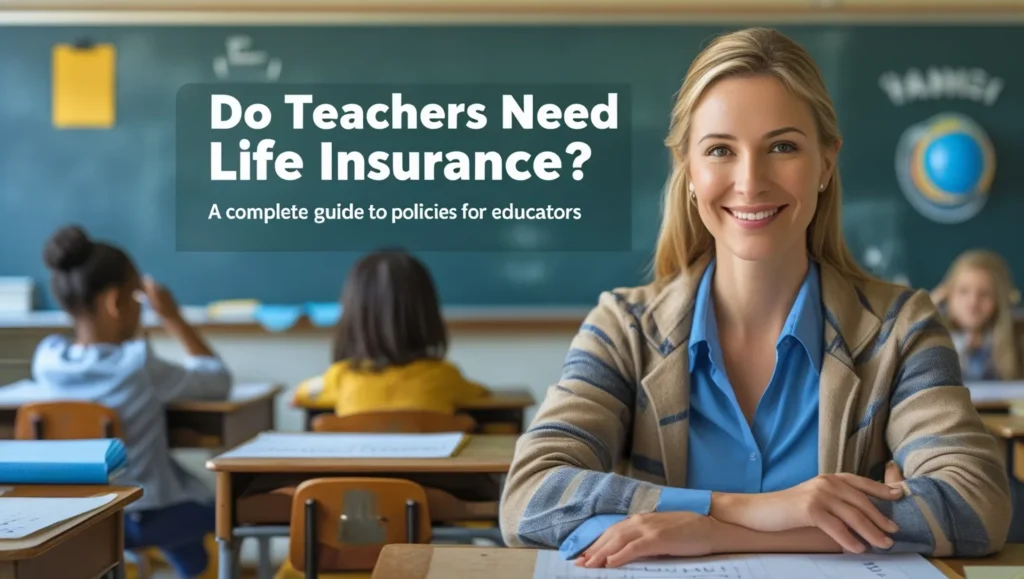
Table of Contents
ToggleIntroduction
Teachers dedicate their lives to nurturing young minds and shaping the future of society. But while they invest in their students’ futures, it’s crucial they also invest in the security of their own families. Life insurance might not be a common topic in the staff room, but it’s an essential financial safety net every educator should consider.
This complete guide will explore why life insurance is important for teachers, the different types of policies available, and how to choose the right coverage depending on individual circumstances. From understanding policy types to determining coverage amounts, we’ll unpack everything educators need to know about protecting their loved ones.
Why Life Insurance is Important for Teachers
1. Protecting Family and Dependents
Many teachers are the primary earners in their households. Whether you’re supporting a spouse, children, or aging parents, life insurance ensures that your loved ones aren’t financially burdened if something unexpected happens to you. It can help cover daily living expenses, future education costs for children, and outstanding debts like mortgages.
2. Supplementing Employer Benefits
Public school districts and universities often provide basic group life insurance policies. However, these are usually limited in coverage—typically 1 to 2 times your annual salary. This might not be sufficient for families with long-term financial needs. Teachers should consider purchasing additional individual policies to fill the coverage gap.
3. Covering Funeral and End-of-Life Expenses
Funeral costs can range from $7,000 to $12,000 or more. A life insurance policy can cover these costs, preventing family members from facing unexpected expenses during a difficult time.
4. Locking in Lower Premiums Early
Life insurance premiums increase with age. Teachers in their 20s, 30s, or early 40s can secure significantly lower premiums by purchasing life insurance early in their careers, locking in affordable rates for decades.
5. Supplementing Retirement Benefits
While many teachers receive pensions, these may not be enough to support their families after passing. Life insurance can supplement retirement benefits and ensure financial security for dependents.
Types of Life Insurance for Teachers
1. Term Life Insurance
Term life insurance is one of the most affordable and straightforward types of life insurance. It provides coverage for a specific period—usually 10, 20, or 30 years. If the insured person dies during the term, the death benefit is paid to the beneficiaries.
Best for:
Teachers with young children or mortgages
Those looking for affordable, high-value coverage
Individuals wanting coverage during their working years
Pros:
Lower premiums
Simple to understand
High death benefit for a low monthly cost
Cons:
No cash value
Expires at the end of the term
2. Whole Life Insurance
Whole life insurance offers lifetime coverage and includes a cash value component that grows over time. A portion of your premiums goes into this cash value, which you can borrow against or withdraw later.
Best for:
Teachers seeking lifelong protection
Those wanting a forced savings component
Educators planning estate transfers
Pros:
Lifetime coverage
Cash value accumulation
Premiums remain fixed
Cons:
Higher premiums than term insurance
Can be complex to manage
3. Universal Life Insurance
Universal life insurance is a type of permanent insurance that offers flexible premiums and death benefits. It also accumulates cash value but allows more control over how premiums are paid and how the cash value grows.
Best for:
Teachers with fluctuating income or side jobs
Those wanting flexibility in payments
Pros:
Flexible premiums
Lifetime coverage
Tax-deferred growth of cash value
Cons:
Can become expensive over time
Requires active management
4. Group Life Insurance (Through School Districts)
Most public school systems and some private schools offer group life insurance as part of employee benefits. While this is a helpful start, it typically offers limited coverage and may not be portable if you change jobs.
Best for:
Initial or supplemental coverage
Teachers who want free or low-cost coverage
Pros:
Often free or subsidized by employers
No medical exam required
Cons:
Limited coverage amount
May end when employment ends
Comparison of Life Insurance Options for Teachers
| Insurance Type | Coverage Duration | Cash Value | Premium Costs | Best For |
|---|---|---|---|---|
| Term Life Insurance | 10-30 years | ❌ No | 💲 Low | Young teachers, budget-conscious educators |
| Whole Life Insurance | Lifetime | ✅ Yes | 💲💲💲 High | Long-term planners, those who want savings growth |
| Universal Life Insurance | Lifetime | ✅ Yes | 💲💲 Medium to High | Teachers wanting flexibility in premiums & investments |
| Group Life Insurance | As long as employed | ❌ No | 💲 Low or Free | Teachers looking for basic employer-sponsored coverage |
How Much Life Insurance Do Teachers Need?
The amount of life insurance needed depends on several factors, including income, debts, family expenses, and future financial goals. A common guideline is to purchase coverage that is 5 to 10 times your annual salary.
Key Considerations:
✅ Dependents: If you have children, you may need higher coverage to support their education and living expenses.
✅ Debt and Loans: Factor in student loans, mortgage payments, and other outstanding debts.
✅ Retirement and Savings: If you have limited savings or pension benefits, life insurance can fill the financial gap.
Example Scenarios:
Single Teacher with No Dependents: A small-term life policy (e.g., $100,000–$250,000) may be sufficient.
Married Teacher with Children: A policy worth $500,000–$1,000,000 ensures the family’s financial security.
Teacher Nearing Retirement: A mix of whole life and group life insurance can help supplement pension benefits.
Cost of Life Insurance for Teachers
The cost of life insurance varies based on several factors including age, health, policy type, and coverage amount. Here’s an estimated monthly premium comparison for a healthy, non-smoking 35-year-old teacher:
| Policy Type | Coverage Amount | Monthly Premium |
|---|---|---|
| Term (20 Years) | $500,000 | $25 – $35 |
| Whole Life | $250,000 | $150 – $250 |
| Universal Life | $250,000 | $100 – $200 |
Where Can Teachers Get Life Insurance?
1. Employer-Sponsored Life Insurance
Most school districts and universities offer group life insurance as part of employee benefits. Check with your employer to understand the coverage limits and whether additional insurance is needed.
2. Teachers’ Unions and Associations
Organizations such as NEA (National Education Association) and AFT (American Federation of Teachers) provide discounted life insurance plans for members. These are often more affordable than private options.
3. Private Life Insurance Companies
Many educators purchase individual policies from companies like State Farm, Prudential, MetLife, and New York Life, which offer tailored plans for teachers.
4. Online Life Insurance Marketplaces
Websites like Policygenius, Haven Life, and Ethos allow teachers to compare multiple insurance policies and get quotes instantly.
Should Retired Teachers Get Life Insurance?
Yes—life insurance for retired teachers is still beneficial, especially if they:
Have dependents with special needs
Want to leave a legacy or donation
Still have outstanding financial obligations
Don’t want their funeral expenses to burden family members
However, premiums will be higher due to age, so it’s important to weigh the benefits against the cost.
FAQs About Life Insurance for Teachers
Yes. While pensions provide retirement income, they do not provide a lump sum payout for your family in case of death. Life insurance ensures additional financial security.
Yes. Many insurers provide coverage, though premiums may be higher. Some employer-sponsored plans do not require medical exams.
Typically, no. Employer-provided life insurance offers limited coverage, usually equal to 1-2 times your salary, which may not be sufficient for your family's long-term needs.
Yes. Retired teachers can purchase private life insurance, but rates may be higher. Whole life and final expense insurance are good options.
Compare multiple insurers before purchasing.
Buy a policy while young and healthy.
Maintain a healthy lifestyle to lower premium costs.
If you rely on group life insurance through your employer, coverage may end when you leave your job. Consider purchasing an individual policy for continuous protection.
Yes, some companies like Horace Mann specialize in educator discounts and tailored plans. Always ask insurers if educator-specific rates are available.
Term life is better for temporary needs at lower costs. Whole life is ideal for lifelong protection and cash value accumulation. Many teachers combine both for flexible coverage.
Conclusion
Teachers are the backbone of education and community development. While their job involves planning for the academic futures of their students, planning for their own family’s financial future is equally essential. Life insurance ensures that loved ones remain protected even in your absence—covering everything from mortgage payments to children’s tuition.
Whether you’re a young teacher just starting out, a mid-career educator, or a retired school staff member, life insurance is an important investment. Assess your needs, explore your options, and consult a trusted financial advisor to choose the best plan for you.
- Facebook
- Twitter
- Linkedin
- Whatsapp
- Telegram
- Pinterest

